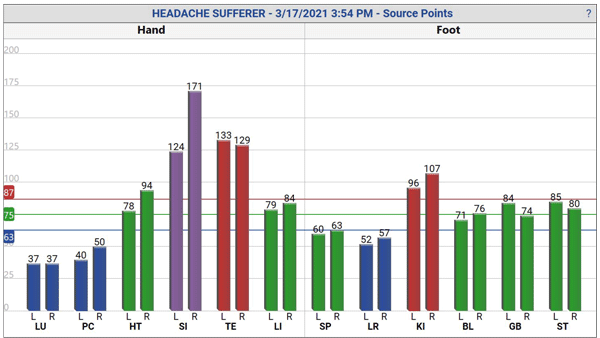Understanding Your E.M.I. AcuGraph Test Results

An extensive amount of useful information can be obtained from an EMI Testing
ing) test graph. While we are not trying to make you an expert at EMI interpretation, we would
like you to be able to understand some of the basics as they relate to your individual test results.
Overview of How the Graph Works
- On the left-hand side of the graph is a vertical line of numbers ranging from 0 to 200. This represents the range in which nerve points are tested and an EMI evaluation is recorded.
- Three horizontal lines (red, green, blue) are present on the graph. A numerical value is assigned by the EMI computer program to each of these lines and is printed at the beginning of the line on the left.
- Any vertical, bar graph, lines that numerically fall within these three horizontal lines are considered within range and normal. (Printed in Green, these will include minimally high or low findings when present.)
- A person with a healthy balanced nervous system will have all of his or her points fall within this normal range and print in Green.
- The numerical range for these three lines will vary depending on the amount of resistance present in your body, and specifically your nervous system, at the time of the test.
- E.M.I. measures the amount of electrical resistance for each meridian/nerve point tested and registers a numerical value between 0 and 200 on its meter. Pairs of points, first left, then right are tested and recorded. In all, 12 pairs of points are tested. These 24 points are then compared, averaged and printed.
- A normal range is established. The three solid horizontal lines across the center of the graph represent the normal range; low, ideal and high.
- A Green bar represents a point falling within the normal range and can also include points that are marginally high or low and less than ideal.
- A colored bar (Red, Blue, Purple or Green) is assigned to any point that:
- falls above the normal range. (designated by Red)
- falls below the normal range. (designated by Blue)
- falls within the normal, high or low, range but is significantly out of balance with its right or left counterpart. (designated by Purple). This is known as a split pathway or meridian.

Visual Examination of Test Results
The following visual observations are helpful in obtaining a general overview of your E.M.I. graph. For details and specific interrelationships, please ask your practitioner.
- The first three pairs of lines of the graph, LU, PC and HT, are important indicators of overall vitality. They are commonly found to be out of balance with the other points on the graph in chronic conditions such as, fibromyalgia, chronic fatigue syndrome, depression, anxiety and low immune system function.
- The next three, SI, TE and LI, have to do with the breakdown and processing of food, the assimilation of nutrients and the body’s hormonal functions.
- The last six pairs of points are important indicators for visceral function. They are good indicators as to how the body is handling toxins, and overall stress from an adrenal standpoint, both on a short and long-term basis.
Treatment Objectives
- The primary objective of treatment is to help improve the function of your nervous system.
- Treatment does not and cannot heal you.
- Only your body can heal itself.
- A poorly functioning nervous system will result in poor cell, organ and tissue function, which will result in poor health. (i.e. Health is determined by function.)
- Consequently, improved nervous system function will improve your health! Improved health, over a long enough period of time is the only thing that can safely improve your symptoms and prevent them from recurring.

Retesting
As your nervous system improves it will be obvious on E.M.I. testing. While improvement should be evident on the E.M.I. test within six weeks, maximum restoration of a person’s nervous system can take months to years.
Numerous factors are in play here:
- A person’s state of health,
- nutritional factors
- stresses (emotional, chemical, physical, etc.)
- treatment schedule cooperation
- a person’s motivational status (being ready, willing and able to participate in the healing process), all effect recovery time.
Retesting is successful when a change from the original E.M.I. is evident.
Two things can happen:
- a gradual change can occur as the test point heads towards normal.
- points may go into flux.
Flux is the term given to a point that undergoes a dramatic change, up or down, in response to treatment. It is a sign that the nervous system is correcting itself. For example, let’s say that the nerve supply to the liver was initially low. As the nervous system is treated it will regain its ability to communicate with and better control the liver.
Next, it may markedly increase liver function in an effort to facilitate the healing process. In the long run, a state of flux is a temporary condition.
Therefore, in this example, the first E.M.I. test showed a low (blue) line and the second test shows a high (red) line. The goal of additional treatment would be to enable the nerve supply to properly regulate itself so a subsequent test would then show that the nerve supply has been restored to the normal range (green line).
Feeling better
Most people come in for treatment because they want to feel and function better. They are, of course, very concerned about when they will start to feel improvement.
For the majority of people this happens relatively soon. As treatment progresses and nervous system function is slowly restored, they experience a slow and steady improvement in their symptoms.
For others, this is not the case. Human physiology being what it is, the road to feeling permanently better may not be a smooth one.
It is entirely possible;
- to feel no change for an extended period of time,
- to feel better early on in treatment and then to feel worse (on and off) until you finally feel better on a consistent basis,
- to feel worse at the onset of treatment or at some point during the course of treatment, before you feel better at all.
Continuing treatment
Our goal is to help you improve your health as much as possible. A normal E.M.I. test result is a realistic goal for almost everyone. How long you decide to benefit from treatment is, of course, always up to you.
Preventive treatment
Once maximum improvement of your nervous system is achieved, you then have the option of receiving some type of preventive care. More and more people are choosing this as a way of maintaining good health.
In the past, many Americans viewed preventive care as unnecessary; in their minds it was like fixing something that wasn’t broken. We’re beginning to realize that nothing could be further from the truth.

Simply put, the only people that do not need preventive healthcare treatments are those that are living a totally stress free life and eating perfectly. I don’t know about you, but that leaves me out!
Sensory Component Overview
(Source EMI and JingWell EMI)
Sensory nerves carry information to the central nervous system, (brain and spinal cord) for processing. Sensations such as pain, temperature, light touch, vibration, position sense (proprioception), smell, vision, sound, etc., are all carried to the brain through sensory nerves.
The efficiency with which this information is carried has a great deal to do with the ease or difficulty in which it is processed and later sent out as motor signals.
Motor signals are the electrical impulses that allow us to think, process information, behave, concentrate, calculate, retain, move, ambulate and animate.
When information is collected and transmitted too quickly, too slowly or markedly differently from the right versus the left, the brain has a much more difficult time processing that information. More effort and energy is required, inefficiency issues and dysfunction results.

The first six pairs of points collectively are associated with the transmission of sensory information from the upper body to the central nervous system.
The first three pairs of lines of the graph, LU, PC and HT, are part of the brachial plexus of nerves and are important indicators of sensory nerve function related to head, neck, shoulders, arms and hands. How these areas of the body collect information is directly dependent on how efficiently nerves from these areas transmit information to the central nervous system.
The next three, SI, TE and LI, are part of the cranial and cervicobrachial nerve plexuses and have to do with the collecting of information from the ears, eyes, nose, face and upper body. The first six pairs of points collectively are associated with the transmission of sensory information from the upper body to the central nervous system.
The last six pairs of points are important indicators of lower body sensory nerve function (predominantly proprioception). They are good indicators as to how efficiently the body is receiving and handling the myriad of proprioceptive information that the brain receives from the body.
*Mandatory disclaimer: This information is offered for educational purposes and as such is not meant to be a substitute for the advice of a qualified professional. It is not intended to be used to self diagnose, treat, cure or prevent any disease.
